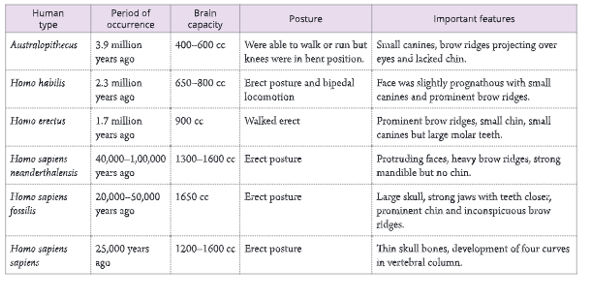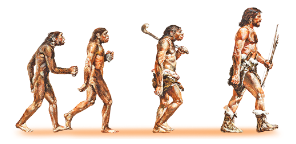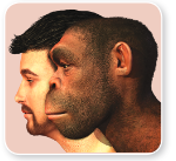UP Board Notes For Class 10 Science Chapter 15 Human Evolution Learning Objectives
After completing this chapter, you will be able to:
- Define the term evolution;
- Describe the evolution of humans;
- Discuss and describe the morphological features of human ancestors;
- List theories of evolution;
- Describe Lamarck’s theory of inheritance of acquired characteristics with examples;
- Describe Darwin’s theory of natural selection: survival of the fittest.
The process of evolution involves a gradual irreversible change or variation in the organisms generation after generation. t means that the organisms of the present day have arisen from ancestors who were more simple in organization.
| Class 10 Science | Class 11 Chemistry |
| Class 11 Chemistry | Transformation of Sentences |
| Class 8 Maths | Class 8 Science |
The following are the causes of evolution:
1. Variations in the gene pool of members of a population.
2. Natural selection favouring accumulation of advantageous variations.
3. Genetic drift or chance selection.
The word evolution has been derived from a Latin word evolvere (L. e: out; volvo: to roll) means to unroll or unfold to reveal modifications or gradual changes. Therefore, evolution is defined as a naturally occurring slow, continuous and irreversible process of change.
UP Board Notes For Class 10 Science Chapter 15 Human Evolution Evolution Of Human
In order to study the evolution of man, various tools such as time dating, excavating and studying fossils as well as determining DNA sequences have been used. There is a great diversity of human forms and features across the planet.
Earlier, skin colour used to be the commonest way of identifying human races. However, there is no biological basis to this notion of human races. All humans belong to a single species, Homo sapiens.
Place of origin of human
- The family of humans (Hominidae) evolved about 20 million years ago. At the same time, its close relatives, the family of chimpanzees, gorillas and orangutans (Pongidae) diverged from it.
- The fossils of prehuman and ancestral human forms are found in East Africa, Asia and Europe, indicating that human’s centre of origin was probably in Africa. The evolution of bipedalism marks the beginning hominids. Hominids is a term used for humans and their immediate ancestors.
- Humans, Homo sapiens, evolved about 1.5 million years ago. The Homo sapiens evolved further to the Neanderthal man followed by the Cro-Magnon man and further the Modern man.
In 1871, Charles Darwin published a book named The Descent of Man. In this book, he suggested that humans evolved from same African ape ancestors that gave rise to the gorillas and chimpanzees.
How did they migrate?
The genetic footprints of humans can be traced back to the African roots. About two-three hundred thousand years ago, some of human ancestors migrated from Africa to West Asia, then to Central Asia, Eurasia, South Asia and East Asia. Then, these ancestors travelled down the islands of Indonesia and the Philippines to Australia. From Australia, they crossed the Bering land bridge to America. They went forward and backward, even moving in and out of Africa. There were various factors such as availability of food, habitat and environmental suitability which directed human evolution.
Evolutionary changes in humans
1. Erect posture (to stand and walk straight)
2. Bipedal locomotion (to free forelimbs)
3. Forelimbs adapted to hold objects
4. Increase in brain size and its complexity (to think intelligently and logically)
5. Articulation of speech for better interaction and communication
6. Formation of chin
7. Reduction in the size of canines
8. Loss of brow ridges.

Ancestors of human beings
The Lemur and Loris are said to be the early ancestors of human beings. Lemur is a small monkey-like animal with a long tail. It lives on trees. The Lemur is the oldest of living primates. A fossil ape Dryopithecus is considered to be the common ancestor of humans and great apes (orangutan, chimpanzee and gorilla). It had large brain, large canines, and feet fossils indicate its semi-erect posture.

The prehistoric man Ramapithecus, lived some 15 million years ago, evolved from Dryopithecus. Dryopithecus was more ape-like while Ramapithecus was more man-like hominid.
UP Board Notes For Class 10 Science Chapter 15 Human Evolution Australopithecus
Australopithecus are believed to have appeared some 3.9 million years ago in grasslands of East Africa. They were able to walk or run on two legs but still retained many ape-like features including adaptations of tree-climbing (long arms, short legs), a small brain, a long protruding jaw, and cone-shaped ribcage.
The cranial capacity was about 400-600 cubic centimetres (cc) and they were 1.2 to 1.5 metres tall. They had a low, sloping forehead, brow ridges projecting over the eyes and a projecting face.
Canine teeth were pointed and of size between that of apes and humans. They used simple tools like sticks and other non-durable plant parts which were found in their immediate surroundings.
Homo habilis (The handy man)
The words Homo habilis is derived from Latin words Homo meaning human and habilis meaning handy or skillful. They were the first early true man to have lived on earth between 2.3 and 1.5 million years ago.
They had a height of about 1.5 metres and cranial capacity of 650-800 cc. The face was slightly protruding, had round skull and teeth with small canines. Brow ridges were present, and they had lightly built lower jaw.
H. habilis had an erect posture and bipedal locomotion. Since they were the first fossil man to have used chipped stone tools, H. habilis were also known as toolmaker.
UP Board Notes For Class 10 Science Chapter 15 Human Evolution Homo Erectus (The upright man)
Homo erectus lived between 1,00,000 and 1.6 million years back and were much larger than H. habilis, about 1.5-1.7 metres tall.
Homo erectus had bigger brain with cranial capacity of around 900 cc and showed structure of brain similar to that of modern humans. The bones of the skull were thick, and they had sloping forehead, flatter face, massive brow ridge, smaller chins and rounded jaw. Arms and legs were in proportion as in modern humans.
They had small canines but molar teeth had large roots. They were first hominid to use fire. H. erectus successfully hunted large animals using flint and bone tools and cooked them over fire.
UP Board Notes For Class 10 Science Chapter 15 Human Evolution Homo Sapiens Neanderthalensis
The Neanderthal man lived in Europe and east and central Asia between 40,000-1,00,000 years ago. Compared to modern humans, they were short and had robust skeletons with muscular bodies adapted for cold.
They had massive skulls with brain capacity of 1300-1600 cc and were 1.5 to 1.6 metres tall. They had protruding face, with thick but rounded brow ridge that lay under a flat and receding forehead. The mandible was strong and jaw lacked the projecting bony chin.
They had larger teeth than those of modern humans. The Neanderthal man lived in caves and built hut- like shelters. They were skilled hunters, made flint-flake tools, cared for their sick and buried their dead.
Homo sapiens fossilis (Cro-Magnon man)
The fossils of Cro-Magnon man were discovered from Cro-Magnon cave in France, hence its name. They lived 20,000-50,000 years back and become extinct about 10,000 years ago.
They were about 1.8 metres tall with less body hair. They had brain capacity of about 1650 cc. They had large skull, broad flat face with high forehead, strong jaws and wisdom teeth with teeth placed together, prominent chin and inconspicuous brow ridges.
They were cave-dwellers; good hunters, made sophisticated tools like stone spears and arrows, knew the use of fires and used ornaments made of ivory. They loved art paintings on cave walls. They domesticated animals.
Homo sapiens sapiens (Modern man)
The modern man appeared some 25,000 years back and spread all over the world about 10,000 years ago. They had undergone slight morpho anatomical changes, such as thinning of skull bones, development of four curves in the vertebral column and brain capacity of about 1200-1600 cc.
Face is reasonably small with a projecting nose, brow ridge is limited and tall forehead. The teeth are relatively small compared to earlier species. This is especially noticeable in the front incisors and canines.
Their jaws are smaller and less protruding. They have wider pelvis, S-shaped spine, angled femur and toe aligned. They have longer thumb and shorter fingers for tool use.
They underwent cultural evolution to adapt to and control surrounding environment. They started cultivating plants and domesticating animals.

UP Board Notes For Class 10 Science Chapter 15 Human Evolution Theories Of Evolution
From time to time, several theories have been put forth to explain the process of evolution of the plants and animals. Some of these theories are described here.
Lamarck’s Theory of Inheritance of Acquired Characters
Jean Baptiste Lamarck (1744-1829) was a French evolutionist. He explained the principal behind evolutionary process in his book named Philosophie Zoologique. Lamarck stressed on adaptation as means of evolutionary modification. His theory is known as theory of inheritance of acquired characters or Lamarckism. The main features of his theory are:
1. Every living organism tends to increase volume of its body and hence increase size upto a certain limit.
2. The development of an organ is directly proportional to its use. The use and disuse of an organ by an organism leads to acquiring of variation or change in the feature of that organ. Continuous and extra use of an organ makes it more efficient while the continued disuse of other organs lead to their degeneration and ultimate disappearance. So, Lamarckism is also called theory of use and disuse of organs. This change occurs due to interaction with the environment.
During its life span, the organism acquires certain new characters due to the environmental influences and are called acquired or adaptative characters.
3. All these changes or variations (called acquired characters) acquired during the life of an individual are transmitted to its offspring, i.e. they are inherited (hence the name theory of inheritance of acquired characters).
4. The favourable variations caused due to use and disuse after long period of time result in evolution of a new species.
UP Board Notes For Class 10 Science Chapter 15 Human Evolution Examples To Support Lamarckism
1. Lamarck took the example of the giraffe in support of his theory.
a.According to Lamarck, there was a time when the giraffes were short-necked.
b.When this short-necked giraffe did not find any vegetation to feed on the ground, they tried to reach the upper part of a tree to eat its leaves.
c. Thus, by making continuous efforts, the neck and forelimbs of giraffe started becoming longer gradually.
d. These acquired characters were inherited by the offspring of the giraffe in successive generations.
e. After a considerable long period of time, the giraffe evolved having a long neck and longer forelimbs than hindlimbs.
This is an example of effect of extra use and elongation of certain organs.
2. Vestigial organs refer to the organ structures that have lost all or most of its original function present in another species, generally present in rudimentary conditions.
For example, vermiform appendix, an appendage of caecum, is believed to have been used by humans’ herbivorous ancestors to digest cellulose.
Wisdom teeth and pinnae (external parts of car in humans) are other examples of vestigial organs. These are some examples which are taken in support of disuse of organ.
UP Board Notes For Class 10 Science Chapter 15 Human Evolution Objections To Lamarck’s theory
Lamarck’s theory of inheritance of acquired characters was strongly criticized by August Weismann. He cut the tails of white mice for continuously 21 generations, however, their progeny did not show any cut tails. Thus, if the inheritance of acquired characters (i.e. cut tail in this case) was a fact then, the tailless mice should have born, which did not happen.
Darwin’s Theory of Natural Selection
Charles Robert Darwin (1809- 1882) explained the evolutionary principle in his famous book The Origin of Species in 1859. He described the origin of species by means of natural selection. His theory is known as Theory of natural selection or Darwinism.

In 1831, Darwin went on a voyage of world exploration on a ship named HMS Beagle and studied the flora and fauna of South America, the Galapagos islands and other islands during his journey. He also studied the population theory of Malthus and then proposed his theory of natural selection. The main points of Darwin’s theory of natural selection are as follows:
1. Living beings have a biotic or reproductive potential and their number grows geometrically.
For example, Paramecium divides three times by binary fission in 24 hours under favourable conditions. At this rate, it can produce about 280 million clones in a month and in five years, it can produce Paramecia having mass equal to 10,000 times than size of the earth.
This will lead to numb of species which will be much more than what can be supported on earth.
2. Limited food and space together form major part of carrying capacity of environment, which is maintained by food chains and biogeochemical cycling. Despite having enormous potential of having large progenies, the size of population of any kind of organism remains within a limit.
This population size limitation is due to struggle between members of a species i.e.intraspecific struggle and within members of different species i.e. interspecific struggle for food, space and mate.
3. There is a competition amongst the organisms for obtaining resources. The struggle eliminates the unfit individuals. The fit organisms possess some favourable variations and they survive and reproduce. This is called natural selection.
For example, during drought, only those plants will survive which transpire less and are able to absorb water from deeper layers of soil.
4. The organisers having favourable variations reproduce and pass on these variations to their progenies generation after generation.
These variations, when accumulated for a long time, lead to origin of a new species.
Later on, with the progress in genetics, the sources of variations were explained and Darwin’s theory was modified. This modified theory is known as Synthetic theory of evolution and nowadays, it is the most acceptable theory of evolution. This theory states that the origin of species is based on the interaction of genetic variations and natural selection.
UP Board Notes For Class 10 Science Chapter 15 Human Evolution Example To Support The Theory Of Natural Selection
The case of the peppered moth in England is the most frequently discussed example of natural selection. This refers to an increase in the number of dark-coloured moths due to increased industrial pollution. This is also referred as industrial melanism.
- There were two varieties of peppered moth, grey or light-coloured and dark-coloured. Before industrial revolution, dark-coloured moths were hardly known. The light-coloured species could easily blend with the lichen-covered trunks of trees while resting. Dark-coloured moths on the other hand, were easily picked up by the predatory birds.
- But due to the increase in sulphur dioxide in air (because of industries), the lichens started to reduce on tree trunks, exposing darker bark which was further darkened by falling smoke particles.
- Now, the light-coloured species became conspicuous and attracted its predators. While dark-coloured species had the advantage of protection.
- Within a period of few years, the industrial or polluted areas saw that the dark species had almost replaced the light species. Through this, moth showed natural selection at work.
UP Board Notes For Class 10 Science Chapter 15 Human Evolution Objections To Darwin’s Theory
Although Darwin’s theory of natural selection got wide acceptance, however, it had certain drawbacks, such as it could not explain how variations arise. Darwinism could not explain the origin of new characters. Scientists also claim that natural selection explains the survival of fittest but could not explain the arrival of fittest.
The main differences between Lamarckism and Darwinism are given in Table.

UP Board Notes For Class 10 Science Chapter 15 Human Evolution Human Evolution Summary
- The evolution is defined as a naturally occurring slow, continuous and irreversible process of change.
- Dryopithecus was more ape-like while Romapithecus was more man-like.
- Australopithecus had cranial capacity of 400-600 cc, was able walk or run, had projecting brow ridges over eyes and small brain.
- H. habilis had cranial capacity of 650-800 cc, having small canines and brow ridges were present.
- H. Erectus had cranial capacity of 900 cc, massive brow ridges and small canines.
- The Neanderthal man were short and robust with brain capacity of 1300-1600 cc, round brow ridges and lived in caves and hut-like shelters.
- Cro-Magnon men were about 1.8 m tall with less body hair and cranial capacity of about 1650 cc.
- Modern man had a brain capacity of 1200-1600 cc and developed four curves in vertebral column.
- Lamarck proposed theory of inheritance of acquired characters also called Lamarckism.
- Darwin proposed theory of natural selection, also called Darwinism.
